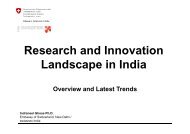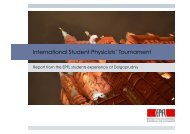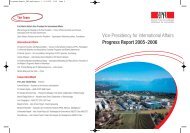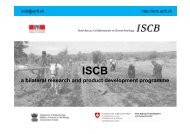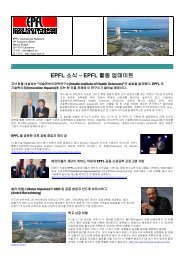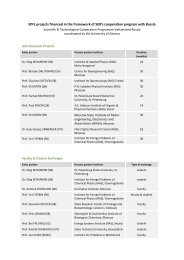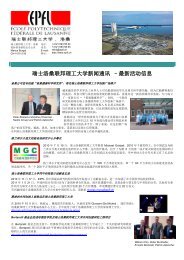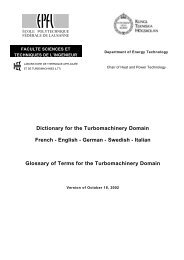Science & Technology News from Japan - International Relations
Science & Technology News from Japan - International Relations
Science & Technology News from Japan - International Relations
Create successful ePaper yourself
Turn your PDF publications into a flip-book with our unique Google optimized e-Paper software.
Schweizerische Eidgenossenschaft<br />
Confédération suisse<br />
Confederazione Svizzera<br />
Confederaziun svizra<br />
Embassy of Switzerland in <strong>Japan</strong><br />
State Secretariat for Education and Research SER<br />
formed into a meshwork with a spacing of several nanometers. Attached along these polymers with a spacing of<br />
just 0.1nm are special molecules that grab hold of the heavy metals.<br />
High-Capacity Lithium Ion Capacitors<br />
(March 27, 2009)<br />
JM Energy Corp. will begin mass production of lithium ion capacitors with a 50% larger capacity than its current<br />
highest-end product. The unit last fall became the world's first company to mass-produce lithium ion capacitors and<br />
now makes up to 25,000 units a month in storage sizes of 500, 1,000 and 2,000 farads. They are used for solar<br />
power stations and uninterruptible power supplies. The new model will boast a capacity of 3,000 farads and will be<br />
sold to manufacturers of construction equipment and large commercial machinery. It will also have a 50% higher<br />
energy density than the products the company now makes.<br />
Coalition For Residential Fuel Cells<br />
(March 27, 2009)<br />
The decision by Toyota Motor Corp. to form a coalition with three other firms for the development of residential fuel<br />
cells is certain to reshape competition in the sector. Toyota and the three others -- Kyocera Corp., Osaka Gas Co.<br />
and Aisin Seiki Co. -- announced that they will jointly develop residential fuel cells called solid oxide fuel cells<br />
(SOFCs). By forming this agreement, Osaka Gas, which has been co-developing SOFCs with Kyocera since 2004,<br />
managed to draw Toyota and Aisin Seiki to its camp.<br />
Low-Cost Carbon Alloy Catalyst For Fuel Cells<br />
(March 31, 2009)<br />
Nisshinbo Industries Inc. plans to begin mass production next year of a carbon-based catalyst that could drive<br />
down the price of fuel cell vehicles by roughly 10%, according to sources. The carbon alloy catalyst is designed to<br />
replace platinum in fuel cell electrodes. The material offers performance comparable to platinum's, but for only onesixth<br />
the cost. It will be shipped to automakers and manufacturers of home-use fuel cells. The high price of platinum<br />
has been one of the hurdles to promoting fuel cells. About 100 grams of platinum is used in the electrode<br />
catalyst of a fuel cell vehicle. Nisshinbo developed the carbon-based material with Gunma University.<br />
Model Project For Bioethanol Made From Rice Straw<br />
(March 31, 2009)<br />
The <strong>Japan</strong>ese Ministry of Agriculture, Forestry and Fisheries has chosen Akita Prefecture <strong>from</strong> among applicants<br />
as a location to conduct a model project utilizing soft cellulose. The model project aims to conduct verification tests<br />
to establish a technology for production of bioethanol made <strong>from</strong> soft cellulose biomass, such as rice straw and<br />
husk that do not compete with food supply. Akita Agriculture Public Corp. will collect and transport the biomass materials,<br />
while Kawasaki Plant Systems has been contracted to produce the biofuel and conduct verification tests of<br />
the biofuel <strong>from</strong> fiscal 2008 through 2012.<br />
7. Space Development<br />
Longest Total Eclipse Of The Sun This Century<br />
(March 05, 2009)<br />
The longest total eclipse of the sun this century, which will blanket natural light for several minutes on July 22, will<br />
be streamed live and broadcast on TV <strong>from</strong> Iwojima Island, as part of a project devised by <strong>Japan</strong>ese astronomers.<br />
The National Astronomical Observatory of <strong>Japan</strong> is preparing to cover the spectacular natural phenomenon by satellite.<br />
It will also use the rare eclipse to study the solar corona. Iwojima Island is one of a handful of spots in <strong>Japan</strong><br />
<strong>from</strong> which it is possible to view the total eclipse. The blackout is predicted to last about 5 minutes and 12 seconds<br />
when viewed <strong>from</strong> Iwojima and about 6 minutes and 25 seconds <strong>from</strong> Akusekijima Island.<br />
Astronaut Going To Make People-Suggested Experiments In Space<br />
(March 08, 2009)<br />
Can eye drops be applied in zero gravity? Is it possible to crawl? Astronaut Koichi Wakata plans to answer these<br />
questions and many more submitted by the public by actually trying them during his time on the <strong>International</strong> Space<br />
Station. Wakata, 45, announced late last month 16 such experiments that he will try during his scheduled three<br />
months in orbit. He received 1,597 individual experiment suggestions <strong>from</strong> about 800 people, ranging <strong>from</strong> primary<br />
school children to people in their 70s, after asking the public for ideas. The eye drop experiment is one of the 16<br />
tests that made the cut.<br />
<strong>Science</strong> & <strong>Technology</strong> <strong>News</strong> <strong>from</strong> <strong>Japan</strong>, Template 2009 • Felix Moesner, <strong>Science</strong> & <strong>Technology</strong> Attaché Page 18 of 28






